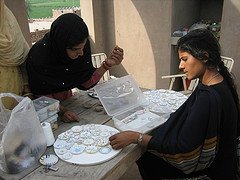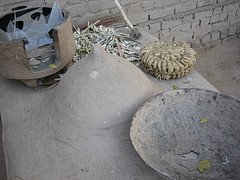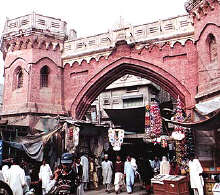Thatta Ghulamka Dhiroka - The Toy Village - is the name of the village in Punjab, about which a lot has been written, about its unique and special concept, Thatta Kedona is the name under which the handicraft products of the village and institutions connected to it within and outside the country are marketed.

“Thatta Kedona” is quite different in nature as compared to other NGO's or similar institutions: Help and support is provided to the people within the countryside, because “if the villagers earn some money, they are not forced to move to the cities, which are already overburdened with many problems”.
The agricultural activity in the village is not sufficient and therefore it is necessary to provide opportunities for additional income in the villages. This can be done by promoting the traditional culture and its conversion into handicrafts. The approach must always be understood in its totality and implemented properly.

The income generated through agriculture may be minimal, it may infact be just sufficient to meets the needs of basic food and simple shelter, but the cost of living in the village is definitely cheaper than the city; the push into the cities enables only the least of the migrants the promised benefits. The steadily increasing productivity of the urban industrial work place ruins not only the rural work place, but specially the life in the city; industrial production and global economics require increase in consumer base and destruction of resources, - in totality therefore not a great concept for the future.

“Thatta Kedona” propagates instead of a a mild effort rather Help Towards Self-Help, “Thatta Kedona” is not an instrument for development and financing of individual family interests nor is it an attempt at religious, political or educational infiltration !
“Thatta Kedona” does not exist with the help of donations or charity of the city dwellers, who may derive satisfaction from a good deed, -this is not compatible with the concept of Help Towards Self-Help: Donations and Alms help only superficially and encourage dependence, -a danger, which was already recognized by the founder of Pakistan and who warned against it.

In the so often propagated Global World, it is of much importance within a state to support Self-Help efforts on one hand to direct the population according to the available resources. If this does not happen, the increasing consumer behaviour kills the initiatives, which becomes known not in the beginning but at a much later stage, when reforms become impossible to implement.
The city culture is international and the problems in the cities worldwide similar, the traditional culture of diverse regions is something special and needs to be protected and supported, - Thatta Kedona is a metaphore for a change in the way of thinking: The future lies in the countryside !

“Thatta Kedona” is quite different in nature as compared to other NGO's or similar institutions: Help and support is provided to the people within the countryside, because “if the villagers earn some money, they are not forced to move to the cities, which are already overburdened with many problems”.
The agricultural activity in the village is not sufficient and therefore it is necessary to provide opportunities for additional income in the villages. This can be done by promoting the traditional culture and its conversion into handicrafts. The approach must always be understood in its totality and implemented properly.

The income generated through agriculture may be minimal, it may infact be just sufficient to meets the needs of basic food and simple shelter, but the cost of living in the village is definitely cheaper than the city; the push into the cities enables only the least of the migrants the promised benefits. The steadily increasing productivity of the urban industrial work place ruins not only the rural work place, but specially the life in the city; industrial production and global economics require increase in consumer base and destruction of resources, - in totality therefore not a great concept for the future.

“Thatta Kedona” propagates instead of a a mild effort rather Help Towards Self-Help, “Thatta Kedona” is not an instrument for development and financing of individual family interests nor is it an attempt at religious, political or educational infiltration !
“Thatta Kedona” does not exist with the help of donations or charity of the city dwellers, who may derive satisfaction from a good deed, -this is not compatible with the concept of Help Towards Self-Help: Donations and Alms help only superficially and encourage dependence, -a danger, which was already recognized by the founder of Pakistan and who warned against it.

In the so often propagated Global World, it is of much importance within a state to support Self-Help efforts on one hand to direct the population according to the available resources. If this does not happen, the increasing consumer behaviour kills the initiatives, which becomes known not in the beginning but at a much later stage, when reforms become impossible to implement.
The city culture is international and the problems in the cities worldwide similar, the traditional culture of diverse regions is something special and needs to be protected and supported, - Thatta Kedona is a metaphore for a change in the way of thinking: The future lies in the countryside !

